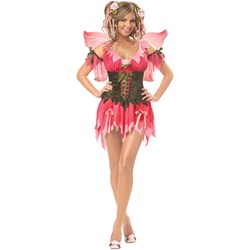A magical minx.
You're evening will be sure to feel like a fantasy in this sexy sprite's style which includes: A fuchsia dress featuring an attached corset with green ribbon lace up detail, light pink underlay and collar, adjustable skirt with ribbon accents and an attached pink rose on the bust. Sheer sleeveletes and fairy wings are also included in this enchanted ensemble.
- Available in Adult Plus Size: XX-Large *Please note:This costume is running small. This size will fit most Adults sizes 14-16.
- Includes: Dress/Corset, Skirt, Sleeves, Wings.
- Does not include hair ties or shoes.
CLICK HERE for more Fairy Costumes
Title: GREAT COSTUME....but!!! Date: Oct 18, 2010
LOVED LOVED LOVED this costume but I was so upset when it didn't totally fit. I am a size 18 with 38D and a belly. With a slimmer this costume is very attractive on me and I would have loved to keep it but the attached corset is definitely made for those with a more hourglass figure. I was able to lace it up from my hips but when it started cinching up around my rib cage it would have never worked. I am broad at my rib cage and this corset didn't look right. Returned this costume and got a quick refund on the product. Just wish that this came in one more size UP...lol

